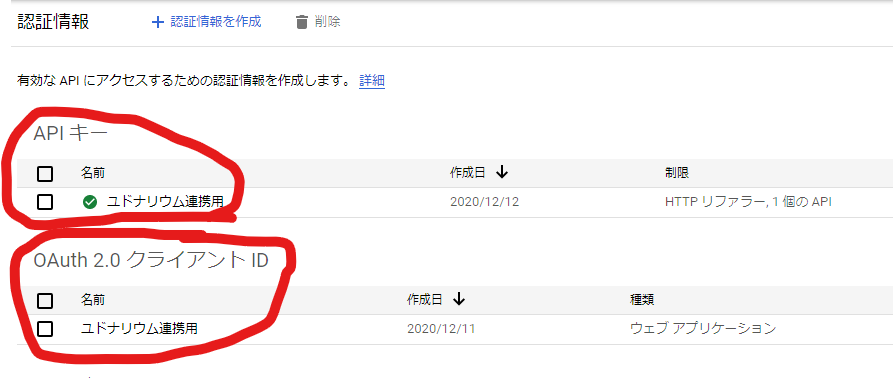概要
前回まではサーバ側でスプレッドシートにアクセスしていた。
クライアント側からのアクセスも試してみる。
基本は、公式ドキュメントの通りに作ればよい。
APIキーとクライアントIDについてはそれぞれ作る必要があるので注意。
認証情報の準備
プロジェクトの準備はできているものとする。*
グーグルクラウドコンソール( https://console.cloud.google.com/?hl=ja ) からログインして認証情報画面に移動。

API キーとクライアントIDの2つを作る必要がある。

APIキーの作成

仕様予定のAPIの有効化を忘れていないかのチェックがてら、制限しておくとよい。
保存を忘れないこと
クライアントIDの作成
開発用のURLや本番用のURLを登録する。IPアドレス(127.0.0.1)では登録できない。
また、OAuth同意画面でスコープを設定するためにhttpsしか登録できない場合がある。後述。

APIキーとクライアントIDのコピー
作成したらコピーする。
ソース
- ポップアップダイアログが表示されるパターン。chromeにはブロックされるので、サンプル通りボタンを作るほうがよいかも。今回はとりあえず動かしたかったのでこれで。
認証
<script async defer src="https://apis.google.com/js/api.js"
onload="this.onload=function(){};handleClientLoad()"
onreadystatechange="if (this.readyState === 'complete') this.onload()">
</script>
<script>
const CLIENT_ID = 'コピーしたクライアントID.apps.googleusercontent.com';
const API_KEY = 'コピーしたAPIキー';
const SCOPES = ['https://www.googleapis.com/auth/spreadsheets'];
const DISCOVERY_DOCS = ["https://sheets.googleapis.com/$discovery/rest?version=v4"];
function handleClientLoad() {
gapi.load('client:auth2', authorization);
}
async function authorization() {
try{
const auth = await authorize()
await gapi.client.init({
apiKey: API_KEY,
clientId: CLIENT_ID,
scope: SCOPES,
discoveryDocs: DISCOVERY_DOCS,
})
}catch(err){
console.log('authError', err)
}
}
function authorize(){
return new Promise((resolve, reject) => {
gapi.auth.authorize({client_id: CLIENT_ID, scope: SCOPES, immediate: false}, function(authResult) {
if (authResult && !authResult.error) {
resolve(authResult)
} else {
reject(authResult.error)
}
});
})
}
</script>
</body>
スプレッドシートに行を追加する部分。若干Node.jsとは書き方が異なるので注意。
const params = {
spreadsheetId: '1JVa25s339f4kNXhdgHXI4dVq3FGMHrT8x7ZvhXKRDMY',
range: 'A1',
valueInputOption: 'USER_ENTERED',
insertDataOption: 'INSERT_ROWS',
};
const body = {
values: [["test","message"]],
}
try {
const response = (await gapi.client.sheets.spreadsheets.values.append(params, body)).data;
console.log(JSON.stringify(response, null, 2));
} catch (err) {
console.error(err);
}
httpsについて
開発用では不便だなと思ったけれど、少し調べたら、webpackのサーバは簡単にhttps化できるようであった。
module.exports = {
//...
devServer: {
https: true
}
};
また、Angularの場合も、以下のコマンドと設定でhttps化することができた。
npm run start -- --ssl
"serve": {
"builder": "@angular-devkit/build-angular:dev-server",
"options": {
"browserTarget": "udonarium:build",
"disableHostCheck": true
},
"configurations": {
"production": {
"browserTarget": "udonarium:build:production",
+ "ssl": true
}
}
},
参考
Google APIを使ったJavaScriptで簡単アンケートページ(iPadアプリ風)
https://python5.com/q/pjgkcqok
https://angular.io/cli/serve
https://github.com/hibohiboo/udonarium/commit/1b32bec57943d201831f7f113c20626183bd86a3

